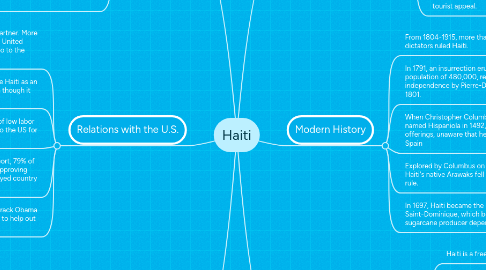Haiti
by Marc Nelson


1. Fun Facts
1.1. During radical ex-priest Jean-Bertrand Aristide’s second term as president, the government established Voodoo as a state religion along with Catholicism.
1.2. The capital Port-Au-Prince was founded in 1749 and was named for the Prince, a French ship anchored in the bay.
1.3. Haiti is the second oldest independent nation in the Western Hemisphere, after the United States.
1.4. The life expectancy for Haiti is low: 50 years for men and 53 years for women.
1.5. Author, statesmen, and ex-slave Frederick Douglass (c. 1818-1895) was an ambassador to Haiti.
2. Travel and attractions
2.1. Labadee - An area located in northern Haiti that is famous for its striking natural beauty and great beaches.
2.2. Petionville is one of the well-liked tourist attractions in Haiti. It is located in the country's capital city and is quite a popular area in Port-au-Prince. Here you will find a lot of the modern amenities.
2.3. Amiga Island - This island is bounded by a good-looking beach but its beauty is further established as you dive into the clear waters.
2.4. If you are into historic sites and would like to see on in Haiti then you should visit Citadelle Laferrirere.
2.5. Plaine du Cul de Sac - This is an accepted landmark in Haiti and is also a significant tourist appeal.
3. Relations with the U.S.
3.1. The United States is Haiti’s biggest trade partner. More than half of Haitian imports come from the United States, and more than 80% of its exports go to the United States.
3.1.1. Project specifications
3.1.2. End User requirements
3.1.3. Action points sign-off
3.2. The United States did not recognize Haiti as an independent nation until 1862 even though it was freed in 1804.
3.2.1. Define actions as necessary
3.3. Haiti enjoys the advantages of low labor costs and tariff-free access to the US for many of its exports.
3.4. According to the 2012 U.S. Global Leadership Report, 79% of Haitians approve of U.S. leadership, with 18% disapproving and 3% uncertain, the highest rating for any surveyed country in the Americas.
3.5. After the 2010 earthquake, Barack Obama sent some U.S. troops to Haiti to help out with relief efforts.
4. Economy/Natural Resources
4.1. Thousands of Haitians were ruined when pyramid investment schemes collapsed. While Haitians lost about $200 million investing in these scams, the co-op founders acquired millions on the proceeds.
4.2. Haiti’s entire annual budget is $300 million, less than that of many small cities in the United States. Since the 1980s, its economy has shrunk steadily.
4.3. Eighty percent of Haitians live under the poverty line and 54% live in abject poverty.
4.4. The average per capita income in Haiti is $480 a year, compared to $33,550 in the United States.
4.5. Natural resources: bauxite, copper, calcium carbonate, gold, marble, hydropower.
5. Modern History
5.1. From 1804-1915, more than 70 dictators ruled Haiti.
5.1.1. Materials
5.1.2. Personel
5.1.3. Services
5.1.4. Duration
5.2. In 1791, an insurrection erupted among the slave population of 480,000, resulting in a declaration of independence by Pierre-Dominique Toussaint l'Ouverture in 1801.
5.3. When Christopher Columbus landed on what he later named Hispaniola in 1492, the people greeted him with offerings, unaware that he was claiming their lands for Spain
5.4. Explored by Columbus on Dec. 6, 1492, Haiti's native Arawaks fell victim to Spanish rule.
5.5. In 1697, Haiti became the French colony of Saint-Dominique, which became a leading sugarcane producer dependent on slaves
6. Politics/Political systems
6.1. Haiti is a free market economy.
6.1.1. Dependencies
6.1.2. Milestones
6.2. Jean-Bertrand Aristide won Haiti’s first free election in December 1990. He fled the country a year later after being ousted in a military coup. He was president again from 1994-1996 and then from 2001 to 2004, when he was ousted again.
6.2.1. Schedule
6.2.2. Budget
6.3. By late August 2011, President Martelly had spent his first 100 days in office without completing his first objective: forming a government. Parliament, led by opposition, turned down his choice for prime minister twice. This left Haiti without a functioning government a year and a half after an earthquake devastated the country, stalling reconstruction efforts.
6.3.1. KPI's
